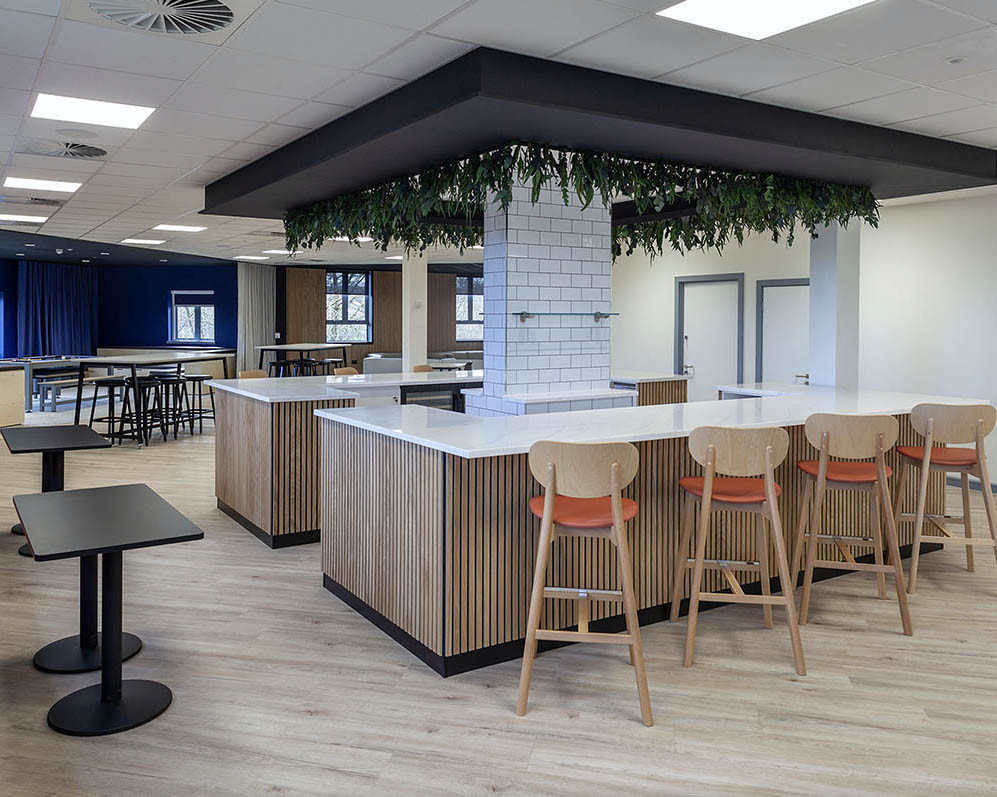We understand more than ever that our work environment shapes our productivity and overall wellbeing. Biophilic design blends design with the intrinsic human affinity for nature.
But what’s the secret to creating a workspace that draws the best talent, nurtures their wellbeing, inspires innovation, and reflects your commitment to sustainability?
The answer is more straightforward than you might think: Nature.
A nature-inspired approach to design
The biophilic design philosophy encourages natural systems and processes in the built environment. The biophilia hypothesis proposes that humans have an innate connection with the natural world, and exposure to nature is important for our wellbeing. In modern-day society, though, time in nature is lacking. While it’s best to go into nature for real, just looking at pictures of natural spaces has been proven to have a similar effect on our mental state.
Biophilic elements like natural light instead of artificial light (which may be problematic for our health), plant life, and water features may reduce stress and promote wellbeing.
Extensive evidence supports the theory that natural elements in our environment are good for us. However, more research is still required to prove that natural textures and materials help us, too.
Here are some ways you can implement biophilic design in your workspace:
Make the most of windows that offer natural light and views of the outdoors where possible.
Introduce plants, living walls, or green dividers.
Use natural materials, textures and colours.
Small water elements like aquariums and indoor fountains can reduce stress and control noise.
Natural light is variable and soft so reflect this in your lighting. Use fixtures that can adjust colour temperature and brightness.
A space which is well ventilated with fresh or purified air, is great for a biophilic feel!
Create or improve access to outdoor spaces.
Think about sound and scent as well as the visual side. Anything that reminds us of the outdoors is beneficial. Your biophilic workspace might use a natural scent diffuser and have a natural playlist.
Use patterns, art and decor that mimic shapes found in nature.
Design workspaces to offer prospect and refuse. This means spaces where employees can observe their surroundings from a safe vantage point and spaces where they can find privacy and quiet.
Is biophilic design just a trend?
Biophilic design is increasing in popularity, but biophilia was introduced as a theoretical framework by Edward Wilson in 1984 and has increased in popularity over time.
Despite the term “biophilic design” being relatively new, there are plenty of historical examples, from the Hanging Gardens of Babylon to Islamic Golden Era architecture. The Umayyad Mosque in Damascus used natural patterns and materials. Like the Ancient Greeks before them, the Romans believed in the importance of living closely with nature, using the elements of Earth, Air, Fire, and Water in their living environments to promote wellbeing. Roman homes were designed with outdoor spaces, nature walls, and with air and noise quality in mind.
We’re all becoming a little more aware about the benefits of nature on human health and the resurgence of biophilic design reflects this. Implementing biophilic elements in work spaces has demonstrated so many positive outcomes. As society grapples with urbanisation and loss of natural space biophilic design offers a way to reconnect with the natural world.
About formm
We’re passionate about revolutionising your workspace through design. Our ethos is rooted in creating aesthetic but practical spaces, nurturing the wellbeing and productivity of everyone who steps into them.
Our process begins with understanding your unique needs and vision; then, through a collaborative design journey, we blend biophilic principles with your company’s culture to create a workspace that looks vibrant and feels alive. A place where creativity can flourish and your staff actually want to spend time.
Leveraging the latest sustainable practices and innovative design, we’re dedicated to delivering workspaces that endure and evolve with your business.
Further reading:
https://journalofbiophilicdesign.com, including a podcast!
Nature Inside: A Biophilic Design Guide,” co-authored by Bill Browning and Catherine O. Ryan
